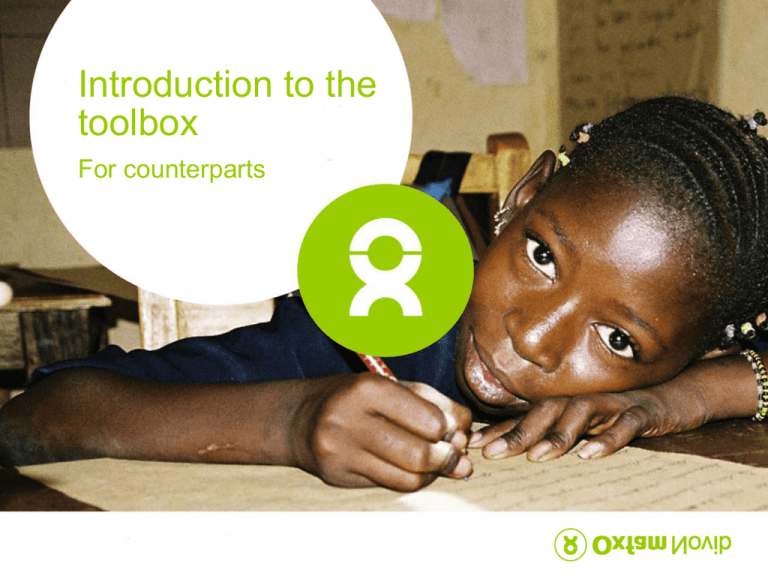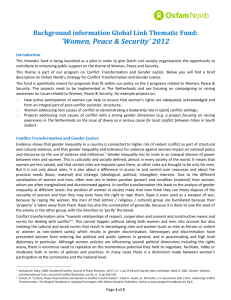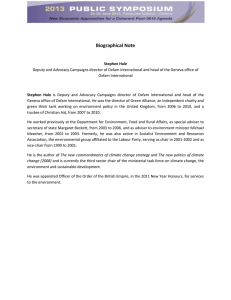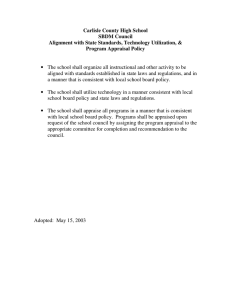Introduction to the toolbox For counterparts
advertisement

Introduction to the toolbox For counterparts 2 ••••••••••••••••••••••••••••••••••••••••••••••••••••••••••••••••••••••••••••••••••••••••••••••••••••••••••••••••••• Agenda for the visit • Before we begin: Have you all read the Frequently Asked Questions and Answers about Oxfam Novib’s appraisal methodology? • Purpose: Build with you our appraisal of the opportunities and risks in our development cooperation. ••••••••••••••••••••••••••••••••••••••••••••••••••••••••••••••••••••••••••••••••••••••••••••••••••••••••••••••••••• 3 ••••••••••••••••••••••••••••••••••••••••••••••••••••••••••••••••••••••••••••••••••••••••••••••••••••••••••••••••••• Expected results of the visit • Clarity about what we need to complete our appraisal of the project for which [ctpt] requests Oxfam Novib funding during [period] • Also, clarity about what is needed to complete the Counterpart and Project Description ••••••••••••••••••••••••••••••••••••••••••••••••••••••••••••••••••••••••••••••••••••••••••••••••••••••••••••••••••• 4 ••••••••••••••••••••••••••••••••••••••••••••••••••••••••••••••••••••••••••••••••••••••••••••••••••••••••••••••••••• Activities during our visit 1 This morning: – introduction to the exercise – gather any additional information that we need 2 This afternoon: – we will finish our draft appraisal 3 Tomorrow morning: – present and discuss with you our analysis of the opportunity and risks – agree with you the indicators of progress towards achieving the results and for controlling the risks ••••••••••••••••••••••••••••••••••••••••••••••••••••••••••••••••••••••••••••••••••••••••••••••••••••••••••••••••••• 5 ••••••••••••••••••••••••••••••••••••••••••••••••••••••••••••••••••••••••••••••••••••••••••••••••••••••••••••••••••• Decision-making steps in Oxfam Novib 1 Pre-assessment by the Oxfam Novib team and agreement to appraise [ctpt] 2 Appraisal, which will be completed following this visit 3 Agreement between us about the Counterpart and Project Description 4 Discussion of both products (appraisal and description) by Oxfam Novib and approval or not of the funding request. No later than [date] 5 Signing of the contract based on the Description and the Appraisal, including our agreement on follow-up and review. ••••••••••••••••••••••••••••••••••••••••••••••••••••••••••••••••••••••••••••••••••••••••••••••••••••••••••••••••••• 6 ••••••••••••••••••••••••••••••••••••••••••••••••••••••••••••••••••••••••••••••••••••••••••••••••••••••••••••••••••• What is risk-taking all about? For Oxfam Novib: “To dare” to make a development cooperation grant that aims to achieve positive outcomes, while running the danger of negative results or even failure. The simple….. • There always exists uncertainty about the results positive or negative - in development co-operation • The probability of positive and negative results varies • Each result has different consequences, whether good or bad. ••••••••••••••••••••••••••••••••••••••••••••••••••••••••••••••••••••••••••••••••••••••••••••••••••••••••••••••••••• 7 ••••••••••••••••••••••••••••••••••••••••••••••••••••••••••••••••••••••••••••••••••••••••••••••••••••••••••••••••••• and the complex…. • Risk is deeply rooted in the reality of different societies, organisations and people. • Thus, our specific historical, economic, political, social, cultural, environmental, institutional, psychological contexts (amongst others!) shape our perceptions about the probability and the consequences of success and failure. ••••••••••••••••••••••••••••••••••••••••••••••••••••••••••••••••••••••••••••••••••••••••••••••••••••••••••••••••••• 8 ••••••••••••••••••••••••••••••••••••••••••••••••••••••••••••••••••••••••••••••••••••••••••••••••••••••••••••••••••• Example of an uncertain event Will it rain tomorrow? And if it does, what should I do? First consideration: What is the probability that it will rain? That depends on: • • • • • My knowledge of the historical pattern The radio forecast My neighbour’s opinion The opposite of what my brother says My intuition That is, everyone’s calculation will depend on our different beliefs about the probability that it will rain or not. ••••••••••••••••••••••••••••••••••••••••••••••••••••••••••••••••••••••••••••••••••••••••••••••••••••••••••••••••••• 9 ••••••••••••••••••••••••••••••••••••••••••••••••••••••••••••••••••••••••••••••••••••••••••••••••••••••••••••••••••• Example of an uncertain event - ctnd. Second consideration: What are the consequences if it rains tomorrow? What are the potential benefits or costs? This calculation depends on: • • • • Whether I walk to work or go by bus or car I like or dislike walking in the rain If I get wet, I am prone to catching the flu Do I have enough money to pay for a taxi? Thus, our decisions about what we will do if we believe it will rain depends on our preferences for the consequences. ••••••••••••••••••••••••••••••••••••••••••••••••••••••••••••••••••••••••••••••••••••••••••••••••••••••••••••••••••• 10 ••••••••••••••••••••••••••••••••••••••••••••••••••••••••••••••••••••••••••••••••••••••••••••••••••••••••••••••••••• In summary • The risk approach to grant-making can help us in Oxfam Novib to form our judgements. Those judgement, however, must be informed through a critical and transparent dialogue amongst ourselves and especially with you. That is the only way to ensure that we have made the best possible decision. It also will enable us to understand each other. ••••••••••••••••••••••••••••••••••••••••••••••••••••••••••••••••••••••••••••••••••••••••••••••••••••••••••••••••••• 11 The essence of the methodology ••••••••••••••••••••••••••••••••••••••••••••••••••••••••••••••••••••••••••••••••••••••••••••••••••••••••••••••••••• OPPORTUNITY PRINCIPAL RISKS The possibility of positive outcom es The potential for negative results ••••••••••••••••••••••••••••••••••••••••••••••••••••••••••••••••••••••••••••••••••••••••••••••••••••••••••••••••••• 12 ••••••••••••••••••••••••••••••••••••••••••••••••••••••••••••••••••••••••••••••••••••••••••••••••••••••••••••••••••• OPPORTUNITY Changes in Policies and Practices SU RE S LT Novib’s Strategic Change Objectives €uros Counterpart’s Objectives ••••••••••••••••••••••••••••••••••••••••••••••••••••••••••••••••••••••••••••••••••••••••••••••••••••••••••••••••••• 13 ••••••••••••••••••••••••••••••••••••••••••••••••••••••••••••••••••••••••••••••••••••••••••••••••••••••••••••••••••• YOUR OUTCOMES ••••••••••••••••••••••••••••••••••••••••••••••••••••••••••••••••••••••••••••••••••••••••••••••••••••••••••••••••••• 14 ••••••••••••••••••••••••••••••••••••••••••••••••••••••••••••••••••••••••••••••••••••••••••••••••••••••••••••••••••• Seven essential questions OPPORTUNITY I. What outcomes does the grantee aim to achieve during the project period? ••••••••••••••••••••••••••••••••••••••••••••••••••••••••••••••••••••••••••••••••••••••••••••••••••••••••••••••••••• 15 ••••••••••••••••••••••••••••••••••••••••••••••••••••••••••••••••••••••••••••••••••••••••••••••••••••••••••••••••••• Smart outcomes • A rule of thumb for assessing what will be achieved and by when: Specific Measurable Achievable Realistic Time-bound ••••••••••••••••••••••••••••••••••••••••••••••••••••••••••••••••••••••••••••••••••••••••••••••••••••••••••••••••••• 16 ••••••••••••••••••••••••••••••••••••••••••••••••••••••••••••••••••••••••••••••••••••••••••••••••••••••••••••••••••• Seven essential questions OPPORTUNITY I. What outcomes aims the grantee to achieve during the project period? II. What are the positive consequences if those outcomes are achieved? III. What is the probability of the counterpart those outcomes? achieving ••••••••••••••••••••••••••••••••••••••••••••••••••••••••••••••••••••••••••••••••••••••••••••••••••••••••••••••••••• 17 ••••••••••••••••••••••••••••••••••••••••••••••••••••••••••••••••••••••••••••••••••••••••••••••••••••••••••••••••••• Seven essential questions PRINCIPAL RISKS IV. What are the potential risks to a grantee being successful in achieving her outcomes? V. What would be the negative consequences if the risks materialise? VI. What is the probability of the risks becoming problems that would undermine achieving the outcomes? ••••••••••••••••••••••••••••••••••••••••••••••••••••••••••••••••••••••••••••••••••••••••••••••••••••••••••••••••••• 18 ••••••••••••••••••••••••••••••••••••••••••••••••••••••••••••••••••••••••••••••••••••••••••••••••••••••••••••••••••• The essence of the methodology OPPORTUNITY PRINCIPAL RISKS The possibility of positive outcomes The potential for negative results In the balance, is the potential of success of the opportunity worth running the principal risks? ••••••••••••••••••••••••••••••••••••••••••••••••••••••••••••••••••••••••••••••••••••••••••••••••••••••••••••••••••• 19 ••••••••••••••••••••••••••••••••••••••••••••••••••••••••••••••••••••••••••••••••••••••••••••••••••••••••••••••••••• NOT DARING TO TAKE END RISKS IS THE GREATEST RISK OF ALL! ••••••••••••••••••••••••••••••••••••••••••••••••••••••••••••••••••••••••••••••••••••••••••••••••••••••••••••••••••• 20 ••••••••••••••••••••••••••••••••••••••••••••••••••••••••••••••••••••••••••••••••••••••••••••••••••••••••••••••••••• END •••••••••••••••••••••••••••••••••••••••••••••••••••••••••••••••••••••••••••••••••••••••••••••••••••••••••••••••••••


